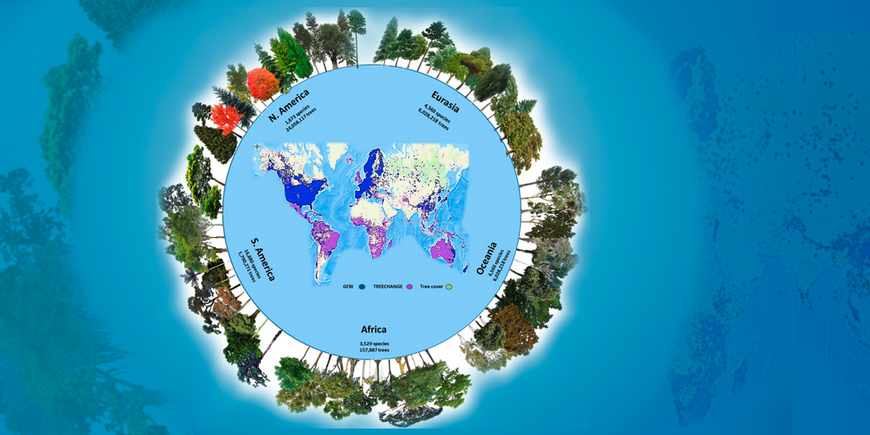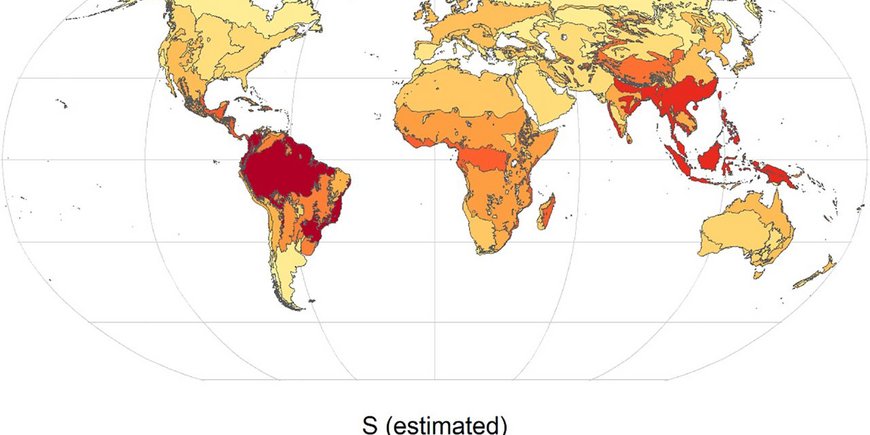Summary
How many species populate the Earth is one of the most fundamental questions in ecology. It is still unsolved, even for the case of well-studied life forms such as trees. Now, researchers from around the world, with the participation of Martin Herold of the German Research Centre for Geosciences Potsdam (GFZ), have compiled their data in the scientific journal PNAS and presented a new estimate for the number of tree species - on biological, continental and global scales. According to the new estimates, there are around 73,300 tree species on Earth, 14 percent more than previously assumed. About 9,000 of them have yet to be discovered, 40 percent of them - according to the researchers' expectations - in South America. Not only one third of the known species, but also most of the undiscovered species are rare, only found on certain continents and in tropical or subtropical regions. Estimating the number of tree species is crucial for informing, optimising and prioritising forest conservation efforts around the world.
Background on biodiversity
Knowledge of the extent of species diversity is important in many ways. First, it can be used to infer the evolutionary mechanisms that have led to diversity - an important basis for predicting future developments. Second, it can help identify which systems are most resilient to global change. And thirdly, an idea of the extent of previously undiscovered and rare species that are at greater risk of extinction is important for biodiversity conservation measures. This also makes it possible to quantify how regional conservation measures work, for example. And ways of predicting extinction, managing diversity hotspots or collecting germplasm can be improved.
In 1994, the renowned theoretical ecologist Robert May of Oxford University was optimistic that by the year 2044, the number of species currently existing on Earth should be roughly known. However, this is still a long way off, even in the case of such important and well-studied life forms as trees. They provide a wealth of ecosystem services for humans and support a large part of terrestrial biodiversity. In particular, there is a lack of a systematised approach. Among other things, it is proving problematic that local knowledge resources are often not well utilised and existing data are not consistent.
New estimate based on globally compiled data
In recent years, the Global Forest Biodiversity Initiative (GFBI) has collected data on tree species diversity from researchers all over the world and systematised them in the context of the now published study, as well as analysing them according to biological, continental and global aspects. This database is essentially based on field counts. Martin Herold, for example, contributed measurements from the tropics. Roberto Cazzolla Gatti (Purdue University (USA) and University of Bologna (Italien)) and Peter B. Reich (Unversity of Minnesota (USA)) were in charge.
On this basis, the researchers have re-estimated the species diversity of trees. According to this, there are about 73,000 tree species worldwide, about 14 percent more than previously assumed. Of these, about 9,000 have yet to be discovered. The researchers expect that about 40 percent of the undiscovered tree species live in South America. Nearly a third of all discovered tree species - and a large part of the undiscovered ones - are rare: They have very small populations and are spatially restricted in distribution, probably in remote tropical lowland areas and mountains.
"The contribution of rare species to ecosystem services is important and a topic of active research. Our results highlight the global diversity and the vulnerability of global forest biodiversity to anthropogenic changes in land use and climate that threaten rare species and thus global tree abundance," the researchers write.
On a continental scale, the researchers paint the following picture of species diversity: about 43 per cent of all tree species on Earth occur in South America, followed by Eurasia (22 %), Africa (16 %), North America (15 %) and Oceania (11 %). However, the researchers point out that the new estimates are also associated with inaccuracies: "This study accelerates our science by estimating global tree abundance tree abundance with a more comprehensive dataset and more advanced statistical methods than previous attempts. However, both the underlying data and the estimators and adjustments are imperfect."
Future tasks and expansion of new measurement methods
"We know the European forests reasonably well, " says Martin Herold, the new head of the GFZ's Remote Sensing and Geoinformatics Section. Particularly in the tropics, where species diversity is greatest worldwide, there are still many areas that have not yet been systematically recorded. "It is important that we in the scientific community have the common goal of also systematically recording the unknown species in the future," emphasises Herold. This is the only way to improve fundamental knowledge about the diversity of life on our planet and its necessary conservation.
"An important basis for this is a next generation of measuring methods," explains Herold. This includes laser scanning, which will be further expanded at the GFZ in the future: A 3D image of the forest can be generated from the ground, via drone or satellite, making virtual inspections and more precise analyses possible. This is an area where we at GFZ will focus on the next years to improve our global understanding and monitoring of forest worldwide.
Original publication: Cazzolla Giatti et al., The number of tree species on Earth, PNAS 2022 Vol. 119, DOI: 10.1073/pnas.2115329119
Scientific contact:
Prof. Dr. Martin Herold
Head of Section 1.4 Remonte Sensing and Geoinformatics
Helmholtz Center Potsdam
GFZ German Center for Geosciences
Telegrafenberg
14473 Potsdam
Phone: +49 331 288-1190
Email: martin.herold@gfz-potsdam.de
Media contact:
Dr. Uta Deffke
Public and Media Relations
Helmholtz Centre Potsdam
GFZ German Research Centre for Geosciences
Telegrafenberg
14473 Potsdam
Phone: +49 331 288-1049
Email: uta.deffke@gfz-potsdam.de









![[Translate to English:] Torsten Sachs in front of a climate station on a field](/fileadmin/_processed_/3/9/csm__TorstenSachs_bearbeitet_GS_4a1365ef84.jpeg)

![[Translate to English:] left image flood at the Ahrtal: image from above, several houses are flooded; left image:: Heidi Kreibich;](/fileadmin/_processed_/4/4/csm_Bild2_9af0130e9f.png)



![[Translate to English:] Start der Vega Rakete](/fileadmin/_processed_/6/4/csm_20231201-kachel_Vega-VV23-launch_ESA-CNES-Arianespace_706716b68c.jpeg)









![[Translate to English:] Poster exhibition at the Brandenburg Hydrogen Day at the GFZ, some participants in the foreground](/fileadmin/_processed_/6/5/csm_Erster_Brandenburgischer_Wasserstofftag_GFZ_402fcec95e.jpeg)
![[Translate to English:] Group picture of the participants](/fileadmin/_processed_/9/4/csm_20231108_CAWa-Workshop-Tashkent_Gruppenbild_99ea779d8a.jpeg)

![[Translate to English:] [Translate to English:] Hörsaal](/fileadmin/_processed_/e/6/csm_H%C3%B6rsal_e21ac645fb.jpeg)


![[Translate to English:] The Delegations in the Historic Library on the Telegrafenberg. In the back there are from left to right, the Dutch Ambassador for Germany, Ronald van Roeden, the Dutch Minister for Education, Culture and Science, Robbert Dijkgraaf and the scientific director of the GFZ, Susanne Buiter.](/fileadmin/_processed_/d/b/csm_Kachel-2_9eba4b4212.jpeg)

